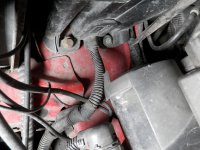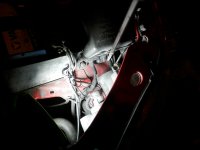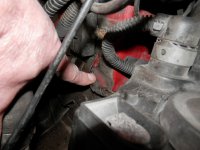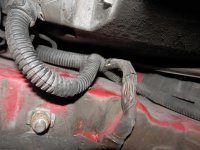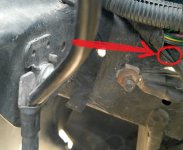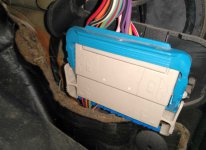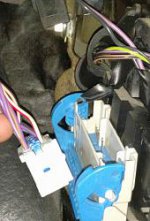For the ignition switch you need a wiring diagram that shows which wire goes where. I might be able to look at the Panda one, but not until Friday.
I found this
http://fiat-punto-cars.info/electrical-systems/210-wiring-diagrams but I didn't find it that helpful.
The fuel system pressure is maintained by the pump. There will be a pressure control of some sort. This might be in the pump, or on the end of the fuel rail that supplies the injectors. Different systems vary. If in the pump there is likely just to be a supply pipe to the injectors. If at the fuel rail, there will be a return pipe to allow the excess to run back to the tank.
When the engine stops, the pressure will gradually fall.
When the ignition is first turned on, the pump will run for a few seconds to pressurise the system, then stop. It stops to prevent it pumping the fuel out if there is as leak.
As the engine is cranked, the pump runs again, for as long as it is cranking.
Once the engine fires, and the key is released to the normal run position, the pump will only continue running if the engine provides either a rotational signal, (crank sensor, cam sensor, ignition distributor, depending on system), or in some cases, if engine oil pressure is ok.
If for any reason the engine stops, a stall, or a crash, that signal will be lost, or oil pressure will drop, so the pump stops. This prevents it pumping the tankful across the road if the crash has damaged the fuel lines.
Older systems mainly used oil pressure as this was a simple switch that said yes/no to the pump relay. Modern systems, the ECU receives some or all of these signals and then tells the pump yes/no, with either a feed or earth for the pump relay.
The relay will have two terminals for the switch, and two that are switched, to supply the pump. You need to ensure you are bridging the feed to the pump.
Thanks for the detailed explanation, it's somewhere along the lines of what I was thinking, what left me puzzled is the fact the pump will run many consecutive times as the ignition is turned on repeatedly, leaving me under the impression that the fuel pressure is not a factor.
I believe I shorted the correct pins on the relay.
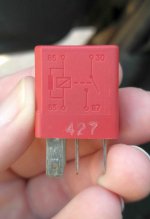
As per this schematics, the two pins on the right are feeding the pump, the two on the left are control pins. I shorted the right pins. Also, I tried repeating this operation a bit earlier with my ampmeter. I measured some 3.5A through the short connection, but the pump didn't turn on. I also measured some 12.5V on these pins.
To make things perfectly clear: I turned the ignition on, the pump didn't operate. I removed the relay and shorted the two pins. Confirmed that I did have a short connection by measuring the current through it. The pump did not operate. I did all of this on the T9 relay, which is the red relay on the left side, in the middle.
Have you seen the pictures of my car's engine area?
I am assuming you do not understand what you are supposed to be doing.
You will need an assistant. the pump only runs for the first 5 seconds after the ignition is switched on.
I'm not certain what lead you to this conclusion. I'll reiterate the issue, maybe I'm missing something.
Normal operation:
1. I turn the ignition on.
2. All dash board lights come on. Only "check engine, battery charge, check oil" remain lit up after the few initial seconds.
3. The fuel pump can be heard below the back seat for something like 5 seconds, as you stated.
Abnormal operation:
1. I turn the ignition on.
2. All dash board lights come on. A varied selection of lights remains lit up after the initial few seconds. Lately, it's mostly "battery charge" and "key coding" lights.
3. I can not hear the pump working.
4. When I try shorting the correct pins (as per above) on the T9 relay, I can not get the pump to work. I can not hear it, therefore I assume it is not working.
I'm an electrical engineer myself, even though not in this area so my experience with electronics is limited, but I fully understand how relays or pumps operate in general. This is a special case, however, as with the underlying issue there are also various signals and test conditions that need to be taken into account.
To confirm, I can not get the pump to turn on by shorting the pins on the T9 relay in the fuse box.
I'm not hoping I'll be able to repair this by myself, but I am hoping I'll manage to understand better what's going on, since I doubt any electrician in the area will be willing to devote that much time to sorting out a number of issues this vehicle is having, which may very well all stem from the same problem, but still. If I take it to any of these guys, they'll just give it minimum priority and it will sit for days on the parking lot before any time is dedicated to it.
Just a note from having a dead key myself
The fkrst few times the car will prime up - but the ecu after a few primes wont always fire up the pump, or if it does its only a split second.....
Abit of a red herring - ignore it
Id defo test that transponder reciever - that connection normally os quiet easy to pop off
Test the ohms of the ring - shouldnt be stupidly high resistance but i dont know the spec of it
Ziggy
Hi Ziggy. Maybe you have missed it, but I have the same issue with both keys. I can't see any difference between using the two.
What you state about the pump, I did experience partially. On some occasions, I would hear the pump operating for just a split second. However, just yesterday I turned the ignition on for some 15 times in just a few minutes, and the pump operated for the full duration as it usually does each and every time. For that reason I became interested about where does that fuel go.
I tried unplugging the connector on the aerial, but it may have been just stuck due to some dust buildup (further stuck thanks to rather high temperatures) and I was reluctant about forcing it. I'll go try again and will measure the resistance.




